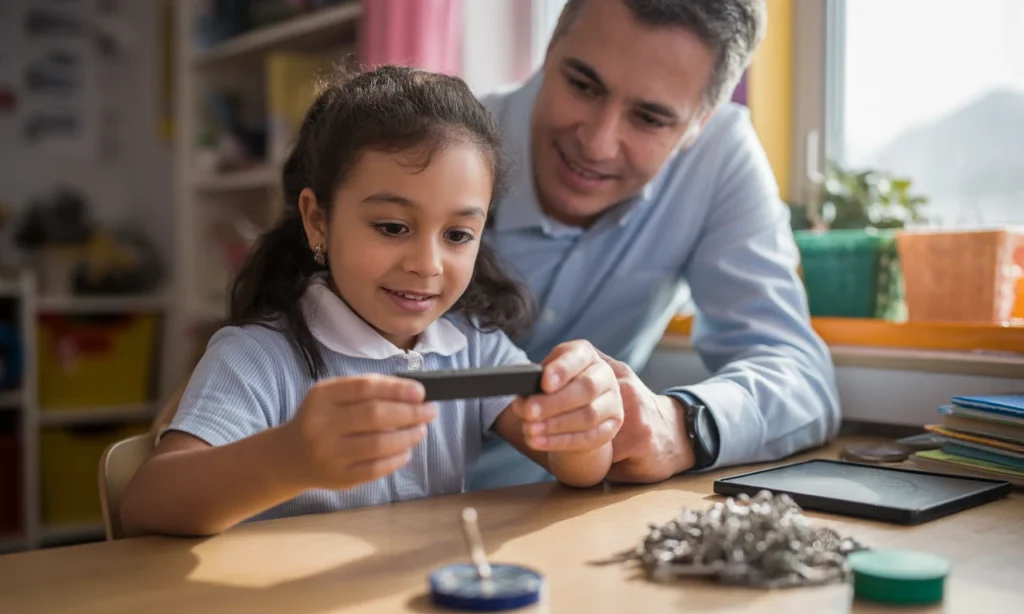Last Updated on October 13, 2025 by XAM CONTENT
New book for CBSE Class 6 Curiosity, Textbook of Science for Grade 6 learners has been published by NCERT as per National Education
Policy (NEP) 2020. Curiosity, Textbook of Science for Grade 6, comprises twelve chapters. Through the chapters, learners will embark on a journey that will connect them to the world around and spark curiosity for further exploration.
We are providing case study questions for class 6 science. Case study questions are the new question format that is introduced in CBSE board. The resources for case study questions are very less. So, to help students we have created chapterwise case study questions for class 6 science. In this article, you will find case study questions for cbse class 6 science chapter 4 Exploring Magnets.
| Chapter | Exploring Magnets |
| Textbook Name | Curiosity |
| Publication Date | July 2024 |
| Type of Questions | Case Study Questions |
| Nature of Questions | Competency Based Questions |
| Board | CBSE |
| Class | 6 |
| Subject | Science |
| Useful for | Class 6 Studying Students |
| Answers provided | Yes |
| Difficulty level | Mentioned |
| Important Link | Class 6 Science Chapterwise Case Study |
Case Study Questions on Exploring Magnets
Questions
Passage 1:
Read the given passage below and answer the questions:
Meena was a very intelligent girl. One day, her father gifted her a bar magnet. She started playing with it. She also explored various properties of the magnet. Her friend told her that there are many other shapes and types of magnets. Magnets are used in appliances, compass and even in making toys. They also realised that there may be two types of objects in the classroom, viz. magnetic as well as non-magnetic. Meena’s father told her to keep this bar magnet safely. If a magnet is hammered, heated, improperly stored, dumped with force or strikes against a hard substance, it loses its magnetic property.

Q. 1. __________is a natural magnet.
(a) Iron stone
(b) Lodestone
(c) Marble
(d) Nickel
Difficulty Level: Easy
Ans. Option (b) is correct.
Explanation: The magnet that is found in nature is a natural magnet. Magnetite and lodestone are examples of natural magnets.
Q. 2. Which of the following is not a type of magnet?
(a) Horseshoe
(b) Cylindrical
(c) Bar
(d) Triangular
Difficulty Level: Medium
Ans. Option (d) is correct.
Explanation: Except triangular, all are the types of magnets.
Q. 3. Consider the following statements about magnets:
(A) A bar magnet has four poles.
(B) The north pole and the south pole are the two poles of a bar magnet.
(C) Poles are associated with electrical energy.
(D) Opposite or unlike poles are attracted to one another.
Difficulty Level: Medium
The correct statements are:
(a) (A) and (B)
(b) (B) and (D)
(c) (C) and (D)
(d) (A), (B) and (D)
Ans. Option (b) is correct.
Explanation: A bar magnet has only two poles-the north pole and the south pole. Magnetic poles generate magnetic forces. Opposite poles of a magnet attract each other, while like poles repel each other.
Q. 4. What is a compass?
Difficulty Level: Medium
Ans. A compass is a device with a magnetised needle pivoted inside a box covered by glass, which points to the north and is a useful tool for finding directions.
Passage 2:
Magnetic and Non-Magnetic Materials
In a class activity, students predicted whether different objects like a pencil, eraser, key, and coin would stick to a magnet. They found that only objects made of iron, nickel, or cobalt were attracted. Others like wood and plastic were not. The teacher explained that materials attracted to magnets are called magnetic materials, and those that are not are called non-magnetic.
Q1. Which of the following is a magnetic material?
(a) Plastic
(b) Glass
(c) Iron
(d) Wood
Difficulty Level: Easy
Answer: (c) Iron
Q2. What do we call materials that are not attracted to magnets?
(a) Neutral materials
(b) Sticky materials
(c) Magnetic materials
(d) Non-magnetic materials
Difficulty Level: Easy
Answer: (d) Non-magnetic materials
Q3. Which of these is likely to not stick to a magnet?
(a) Steel spoon
(b) Wooden ruler
(c) Iron nail
(d) Nickel key
Difficulty Level: Medium
Answer: (b) Wooden ruler
Q4. What conclusion can be drawn from the activity?
(a) Magnets stick to everything
(b) Only plastic items are attracted to magnets
(c) Only some metals are magnetic
(d) Magnets work on water
Difficulty Level: Medium
Answer: (c) Only some metals are magnetic
Also check:
- Beyond Earth Class 6 Case Study Questions Science Curiosity Chapter 12
- Nature’s Treasures Class 6 Case Study Questions Science Curiosity Chapter 11
- Living Creatures Class 6 Case Study Questions Science Curiosity Chapter 10
- Methods of Separation in Everyday Life Class 6 Case Study Questions Science Curiosity Chapter 9
- A Journey Through States of Water Class 6 Case Study Questions Science Curiosity Chapter 8
- Temperature and Its Measurement Class 6 Case Study Questions Science Curiosity Chapter 7
- Materials Around Us Class 6 Case Study Questions Science Curiosity Chapter 6
- Measurement of Length and Motion Class 6 Case Study Questions Science Curiosity Chapter 5
- Exploring Magnets Class 6 Case Study Questions Science Curiosity Chapter 4
- Mindful Eating Class 6 Case Study Questions Science Curiosity Chapter 3
- Diversity in the Living World Class 6 Case Study Questions Science Curiosity Chapter 2
- The Wonderful World of Science Class 6 Case Study Questions Science Curiosity Chapter 1
🚀 Boost Your Exam Prep: Get case study questions for all subjects (Class 6-12) now!
👉 Explore more resources on CBSE Class 6
You may also like
Learning Objectives
- To distinguish between magnetic and nonmagnetic materials.
- To discover the concept of magnetic poles: north and south poles.
- To understand how a magnetic compass works.
- To explore the principles of attraction and repulsion between magnets.
Magnets have unique properties that make them essential in various applications, from navigation to everyday items like purse, pencil box, refrigerator magnets. Understanding magnets involves exploring their materials, shapes and behaviours.
Every magnet is described as bipolar because it has two distinct poles: the North pole and the South pole. This characteristic means that no matter how small or large the magnet is, it will always have one North pole and one South pole at its ends.
Keywords Related to Exploring Magnets
- Magnetic Materials: Substances attracted to magnets, such as iron, nickel and cobalt.
- Magnetic Poles: The two ends of a magnet where the magnetic force is strongest, North and South.
- Magnetic Compass: A device with a needle that aligns with Earth’s magnetic field to show directions.
- Magnetic Attraction: The force that pulls magnetic materials towards a magnet, usually between opposite poles.
- Magnetic Repulsion: The force that pushes magnetic materials away from a magnet, usually between like poles.
🔗👉 Read Also: NCERT Solutions for Class 1 to 12

Frequently Asked Questions (FAQs) on Exploring Magnets Case Study Questions
Q1: What is the new Science textbook “Curiosity” for Grade 6 about?
A1: he new textbook “Curiosity” for Grade 6 Science introduces students to the world of scientific exploration and discovery. It focuses on fostering curiosity and encouraging students to ask questions, observe the world around them, and engage in hands-on activities to understand scientific concepts.
Q2: How is the “Curiosity” textbook different from previous Science textbooks?
A2: “Curiosity” is designed to be more engaging and interactive than previous Science textbooks. It emphasizes inquiry-based learning, where students are encouraged to explore and discover through experiments, observations, and critical thinking rather than just memorizing facts. The textbook is structured around real-world phenomena and everyday experiences to make learning more relevant and exciting for students.
Q3: What are the key themes covered in the “Curiosity” textbook?
A3: The “Curiosity” textbook covers a wide range of themes, including the natural world, physical processes, and basic principles of life sciences. It explores topics such as the properties of materials, the functioning of living organisms, energy, forces, and environmental studies, all while emphasizing the importance of curiosity and inquiry in the learning process.
Q4: How does “Curiosity” support the development of scientific thinking in students?
A4: “Curiosity” supports the development of scientific thinking by encouraging students to ask questions, make observations, conduct experiments, and analyze their findings. The textbook includes activities and projects that help students apply the scientific method, fostering critical thinking, problem-solving, and a deeper understanding of scientific concepts.
Q5: How does “Curiosity” prepare students for higher grades in Science?
A5: “Curiosity” lays a strong foundation for higher grades by introducing students to key scientific concepts and developing their inquiry-based learning skills. By fostering curiosity, critical thinking, and problem-solving abilities, the textbook prepares students for more advanced scientific studies in the middle and high school levels.
Q6: What is magnetic force?
A6: The force exerted by a magnet on magnetic materials in its magnetic field is called magnetic force.
Q7: What will happen if a magnet is heated?
A7: It loses its magnetic property.
Q8: How will you convert an iron nail into a magnet?
A8: Take the iron nail and keep it on the table. Now, take a bar magnet and drag one end of the bar magnet over the iron nail from one end to the other. This process is repeated again and again. The iron nail is converted into a magnet.
Q9: Give two uses of a magnet.
A9: They are used in magnetic compasses and electric motors.
Q10: Are there any online resources or tools available for practicing class 6 science “Exploring Magnets” case study questions?
A10: We provide case study questions for CBSE Class 6 Science on our website. Students can visit the website and practice sufficient case study questions and prepare for their exams. If you need more case study questions, then you can visit Physics Gurukul website. they are having a large collection of case study questions for all classes.



